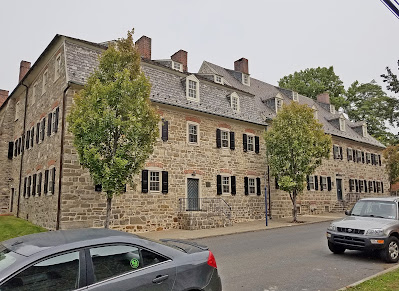Thursday, September 17, 2020 (continued)
Because the Sigal Museum in Easton was closed, and Easton is relatively small, we still had time to zip over to the next "town" of Bethlehem, PA.
 |
Bethlehem is headquarters of Just Born Quality Confection
(1923), maker of Peeps, the traditional Easter marshmallow treat |
 |
Note the license plate of the Peepsmobile
|
 |
Peeps bench at the bus shelter
|
A stop at the Colonial Industrial Quarter, the earliest industrial park in the American colonies:
Bethlehem was founded in 1741 by a group of Moravians from Germany who initially immigrated to the British colony of Georgia for missionary purposes. However, they were expected to engage in military activity that was against their pacifist principles. The Moravians ended up settling here near a spring source at the confluence of the Monocacy Creek and Lehigh River. The town was christened Bethlehem on Christmas Eve of 1741, inspired by Count Nicholas Von Zinzendorf who sang a hymn about Bethlehem. They developed about 50 industries, farmed and raised cattle, becoming a self-sufficient closed community. In 1844-1845, the property was opened up for sale to non-Moravians.
 |
Oil mill remnant, the first was built in 1745; the oil mill had
machines to process linseed oil, crush tanbark, grind groats,
make snuff, full/shrink leather, and soften hemp fibers for clothing |
 |
Waterworks (1762) used water wheels to power pumps that forced
spring water up the hill to a water tower, where gravity then
distributed the water to four cisterns located throughout town |
The Bethlehem waterworks is considered the first pumped municipal water system in the American colonies.
 |
Tannery (1761), Luckenbach Mill (1869 grist mill), and
Springhouse (1970 reconstruction of 1764 structure) (KSS)
|
 |
Next to the Tannery was the Butchery (1752), now in ruins
|
 |
Dye House (1771) ruins (KSS)
|
 |
| Grist Miller's House (1782, addition 1834) (KSS) |
 |
| The Grist Miller's House needs lots of support! |
 |
Historic Ohio Road followed an early
Native American trail |
 |
Ohio Road stone bridge (c 1820 to replace
a wooden bridge at least from 1766) |
 |
Dye House and Clothweavers' Shop (1759) ruins
|
 |
| Miller's House Garden replicating an 1870 garden (KSS) |
 |
Smith Complex (1750) housed the blacksmith,
nailsmith, and locksmith
|
 |
Pottery (1749) ruins
|
Leaving colonial Bethlehem...
 |
Hotel Bethlehem (1922, by Ritter & Shay,
inn Romanesque Revival style) was funded
by Charles M Schwab, steel magnate who
turned Bethlehem Steel into the world's
largest independent steel producer |
 |
Roadside America Nittany Lion Bench (2013)
features Penn State University's mascot |
The Nittany Lion Bench was commissioned by the Lehigh Valley campus of Penn State, but now resides in front of the Hotel Bethlehem that in 2014 opened a Penn State Creamery Ice Cream Parlor across the street. (The Nittany Lion is a
Puma concolor couguar/Eastern Mountain Lion named for Mount Nittany that overlooks the main Pennsylvania State University campus in State College, PA.)
 |
"Pilgrim" Fountain (c 1911)
|
 |
Goundie House (1810, in Federal style, for the
Moravian brewer, John Sebastian Goundie)
is considered to be the first brick
residence in Bethlehem |
 |
| Goundie House door with square wreath |
 |
Eliza Richardson Fountain (1884) was a
bequest from philanthropist Eliza Richardson |
 |
| We had lunch at Fegley's Bethlehem Brew Works (1998) |
 |
Interesting features at 84 W Market Street
|
 |
| Detail at 84 W Market Street |
 |
Nain-Schober House (1758) was originally built in the
Christianized American Indian village of Nain one mile away,
but was dismantled in 1765 when the Pennsylvania colonial
government forced the Native Americans to move west |
The Nain-Schober House is the only extant 18C building built by and lived in by the native people of Eastern Pennsylvania.
 |
Bust of David Zeisberger, considered to be the
greatest of the Moravian missionaries to the
Lenape/Delaware native people; he followed
the Lenape to Ohio when they were forced to
leave Pennsylvania, and helped establish the
villages of Schoenbrunn and Gnadenhutten |
 |
The rear of Bell House and the chapel (1751)
that served as the second Moravian church in Bethlehem |
The Moravians are one of the oldest Protestant denominations in the world, as Unitas Fratrum or Unity of the Brethren, that began in 1457 in what is now the Czech Republic. After years of persecution, they immigrated to Germany in 1722, and settled in a corner of the estate of Count Nicholas Von Zinzendorf in Saxony, who became their patron. The Count also organized the Moravians to live in groups called Choirs, based on age, gender, and marital status.
 |
Gemeinhouse/Community House (1741 as a log house),
the largest 18C log building in continuous use in the United States,
was used as the first place of worship for the Moravians |
 |
| Ryan in the kitchen, Maddy with Fiona and Felix (KSS) |
Many thanks to the NC S family for letting us crash at their awesome NY place, and eating their food. Big shout out to Fiona for keeping Aunt Tamiko entertained and exercised!
Next: Rhode Island.



































No comments:
Post a Comment